Module 5 A Lesson in a Lab
教学设计整合-MODULE 5 A Lesson in a Lab
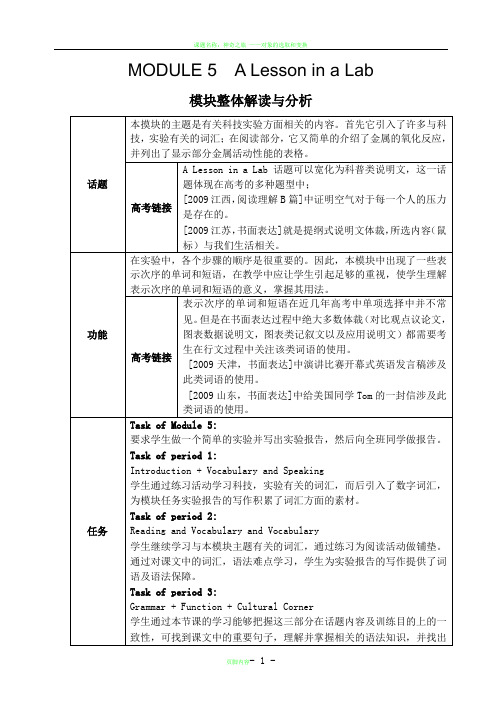
Grammar+Function+Cultural Corner
该部分继续引入与本模块主题有关的词汇,通过练习为阅读活动作了铺垫。精讲课文中的难点,而Vocabulary部分引入了表示实验仪器的词汇,并介绍了带分数的读法,在课文中可以大量使用,二者可以结合进行,成为一节阅读课,语法相结合的课。
[2009江西,阅读理解B篇]中证明空气对于每一个人的压力是存在的。
[2009江苏,书面表达]就是提纲式说明文体裁,所选内容(鼠标)与我们生活相关。
功能
在实验中,各个步骤的顺序是很重要的。因此,本模块中出现了一些表示次序的单词和短语,在教学中应让学生引起足够的重视,使学生理解表示次序的单词和短语的意义,掌握其用法。
正确把握听力内容中实验中师生的对话,填写相关实验活动。学会描述实验过程中的各种语言形式,通过写作反思本模块任务完成情况,及时查漏补缺。
Task of period5:
Writing +Module File
结合前几节课所学的知识,做一个简单的实验报告,向全班做报告。就所写的a report on a simple scientific experiment 进行小组评价,并总结后在全班汇报,就自己在本模块中的学习进行自我评价反思自己的学习。最后整合本模块重点内容,归纳小结。
结构
语法:形容词和副词的比较极:倍数的表示法
其它
Numbers ,fractions and percentages
教学目标
语言知识
能理解相关生词在所学材料中的含义;
运用expand,contract;
掌握“科学与实验”的相关词汇和短语
语言技能
Reading:能从文章中获取和处理主要信息及所需信息
高中英语-Module-5-A-Lesson-in-a-Lab-Reading-and-vocabu
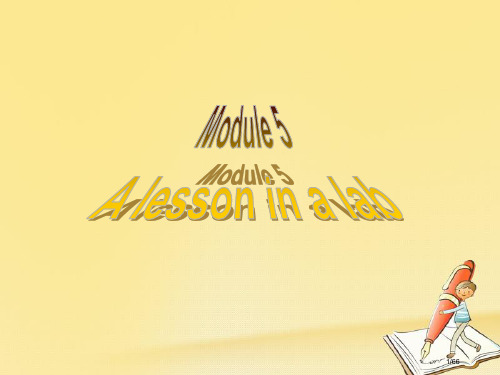
37/66
Passage B – 1.Pre-reading (1m)
Q: Can we put nails in wet air?
38/66
Passage B – 2.Prediction(1m) Put the
words in the right place of the
AimAn
experiment
use metals?
It is important to know how they
react with different substances.
2. Which metal reacts most with wPoattaesrs,iupmotraesasctisummoostr wiriothn?water.
21/66
铝 aluminium
22/66
Calcium
23/66
钙 calcium
24/66
Magnesium
25/66
镁 magnesium
26/66
Zinc
27/66
锌粒 zinc
28/66
Iron
29/66
铁 iron
30/66
Copper
31/66
铜 copper
32/66
44/66
3.In the second part of the
experiment, you must__b_o_i_l__
the water to make sure there is no
___a_i_r___ in it.
4.You add ___o_i_l ___ to the water because this keeps ____a_ir____out
Module 5—A lesson in a lab课文翻译解析
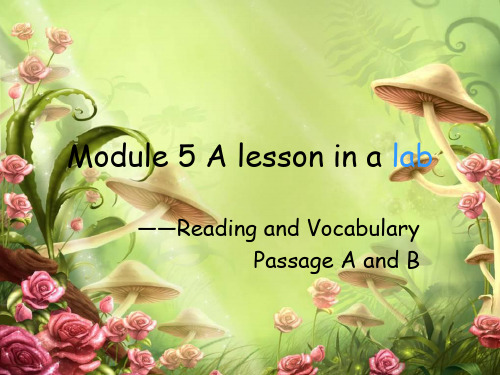
铁在无空气的水中 方法:(1)把试管中加入一半水; (2)将水烧开保持3分钟(这样可以保证 水中无 空气); (3)在水中放2~3枚洁净的铁钉; (4)在水中加些油,这样做可以防止空气进入水 中; (5)把试管放置一周。 结果:铁钉在没有空气的水中未生锈。 结论:铁在没有空气的水中不生锈。 铁在普通的水中 方法:(1)在试管中加入一半水,并在水中放2~3枚洁 净的铁钉; (2)把试管放置一周。 结果:铁钉在含有普通水的试管中生锈。 结论:铁在普通的水中会生锈。
Translation B
一个简单的科学实验 下面是对一个简单科学实验的描述。它向我们表明了铁是 怎样与空气和水反应的。 目的: 弄清铁是否在下列状态下生锈:(a)在干燥的空气中;(b) 在没有空气的水中(没有空气的水);(c)在普通的水中。 仪器: 3颗洁净的铁钉、试管、试管夹、棉花、油、本生灯(即煤气灯 或是喷灯) 铁在干燥的空气中 方法:(1)把若干铁钉置于试管底部; (2)顺着试管塞入一些棉花;(3)把试管放置一周。 结果:一周后,铁钉未生锈。 结论:铁在干燥的空气中不生锈。
• • • • •
• • •
•
Leave sth+地点 把某物落在某地 Leave sth. With sb. 把某事/某物委托给某人 Leave sth. behind 把某事/某物抛在后面 Conclusion n. 结论 Come to a conclusion = reach a conclusion =draw a conclusion 得出结论 in conclusion 最后 boil vt. 煮;煮沸 boiling water 正沸腾的水;boiled water 烧开的水 类似的还有:the rising sun 正升起的太阳 the rised sun 升起的太阳 a developing country 发展中国家 a developed country 发达国家
Module 5 A Lesson in a Lab
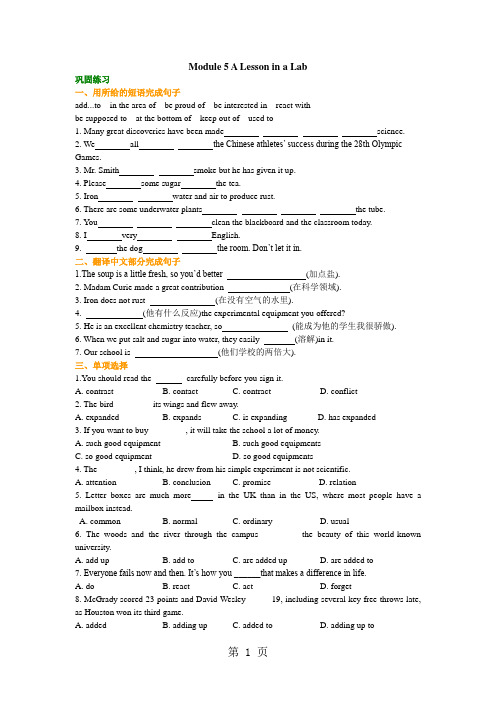
Module 5 A Lesson in a Lab巩固练习一、用所给的短语完成句子add...to in the area of be proud of be interested in react withbe supposed to at the bottom of keep out of used to1. Many great discoveries have been made science.2. We all the Chinese athletes’ success during the 28th Olympic Games.3. Mr. Smith smoke but he has given it up.4. Please some sugar the tea.5. Iron water and air to produce rust.6. There are some underwater plants the tube.7. You clean the blackboard and the classroom today.8. I very English.9. the dog the room. Don’t let it in.二、翻译中文部分完成句子1.The soup is a little fresh, so you’d better (加点盐).2. Madam Curie made a great contribution (在科学领域).3. Iron does not rust (在没有空气的水里).4. (他有什么反应)the experimental equipment you offered?5. He is an excellent chemistry teacher, so (能成为他的学生我很骄傲).6. When we put salt and sugar into water, they easily (溶解)in it.7. Our school is (他们学校的两倍大).三、单项选择1.You should read the carefully before you sign it.A. contrastB. contactC. contractD. conflict2. The bird ________ its wings and flew away.A. expandedB. expandsC. is expandingD. has expanded3. If you want to buy ________, it will take the school a lot of money.A. such good equipmentB. such good equipmentsC. so good equipmentD. so good equipments4. The ________, I think, he drew from his simple experiment is not scientific.A. attentionB. conclusionC. promiseD. relation5. Letter boxes are much more in the UK than in the US, where most people have a mailbox instead.A. commonB. normalC. ordinaryD. usual6. The woods and the river through the campus ________ the beauty of this world-known university.A. add upB. add toC. are added upD. are added to7. Everyone fails now and then. It’s how you ______that makes a difference in life.A. doB. reactC. actD. forget8. McGrady scored 23 points and David Wesley______19, including several key free throws late, as Houston won its third game.A. addedB. adding upC. added toD. adding up to9. She is shy. She is not used to ______in front of others.A. praiseB. praisingC. being praisedD. be praised10. Frampton was ______ to be going through a cure for his disease, but now he doubted whether this visit to the village would help.A. readyB. supposedC. sureD. worried11. The news ______ us so much that all of us were ______ at it.A. astonished; astonishedB. astonishing; astonishingC. astonished; astonishingD. astonishing; astonished12. About 60 percent of the students ______ from the south, the rest of them ______ from the north and foreign countries.A. are; isB. are; areC. is; areD. are; are四、完形填空Do some animals have certain mental powers which human beings do not? Of course they have instincts(本能), but __1__ this, I am sure that they can feel __2__ things which we humans cannot. A personal experience __3__ this to me.Some years ago, I had a dog named Howard. From the time that he was a baby dog, he was timid, so we named him “Howard” to _4__ with “coward”(胆小鬼) ! He was especially afraid of __5__. At the first hint of them, he would run crying into the house and hide under a table. What a hero!I often went for walks with Howard. __6__,as we were walking along a road, it began to rain.I quickly ran to a bus stop for _7__. The bus stop had a roof supported by metal poles. Soon after I had got there, Howard caught my __8__ in his teeth and tried to pull me away. __9__, I was puzzled and a little angry at his 10 .However, I decided to humour him and walked away from the shelter into the rain and __11__ for home.__12_ I was about two hundred metres away from the shelter, there came a blinding flash of lightning and __13__, there was a crash of thunder which nearly _14__ me. Howard stopped walking and began crying. Knowing that he was afraid, I __15__ to pick him up.As I straightened up, I __16__ the bus shelter which we had just left. I was shocked to see that two of the _17__ were bent and the roof was lying on the ground, __18__.The shelter had been struck by the lightning. I gave Howard a big hug to express my heartfelt __19__. He had just saved my life. He was truly my _20__!1. A. for B. besides C. with D. except2. A. certain B. few C. several D. great3. A. expressed B. conveyed C. proved D. applied4. A. rhyme B. meet C. fight D. compete5. A. people B. buses C. cats D. thunderstorms6. A. However B. Once C. Unfortunately D. Suddenly7. A. peace B. relief C. shelter D. comfort8. A. collar B. sleeve C. hat D. trousers9. A. At first B. At last C. At once D. At present10. A. teeth B. behaviour C. courage D. idea11. A. looked B. dreamt C. headed D. asked12. A. Because B. Since C. When D. Before13. A. long after B. minutes later C. at the same time D. soon after14. A. deafened B. struck C. killed D. defeated15. A. went B. bent C. rushed D. turned16. A. glared at B. stared at C. glanced at D. aimed at17. A. buses B. trees C. walls D. poles18. A. broken B. unharmed C. dangerous D. dead19. A. happiness B. thanks C. luck D. wish20. A. dog B. son C. hero D. friend五、阅读理解For years I wanted a flower garden. I’d spend hours thinking of different things I could plant that would look nice together.But then we had Matthew. And Marvin. And the twins, Alisa and Alan. And then Helen. Five children. I was too busy raising them to grow a garden.Money was tight, as well as time. Often when my children were little, one of them would want something that cost too much, and I’d have to say, “Do you see a money tree outside?Money doesn't grow on trees, you know.”Finally, all five got through high school and college and were off on their own. I started thinking again about having a garden.I wasn’t sure, though. I mean, gardens do cost money, and after all these years I was used to living on a pretty lean, no-frills budget.Then, one spring mor ning, on Mother’s Day, I was working in my kitchen. Suddenly, I realized that cars were tooting their horns as they drove by. I looked out of the window and there was a new tree, planted right in my yard. I thought it must be a weeping willow, because I saw things blowing around on all its branches. Then I put my glasses on—and I couldn’t believe what I saw. There was a money tree in my yard!I went outside to look. It was true!There were dollar bills, one hundred of them, taped all over that tree. Think of all the garden flowers I could buy with one hundred dollars! There was also a note attached: “IOU eight hours of digging time. Love, Marvin.”Marvin kept his promise, too. He dug up a nice ten-by-fifteen foot bed for me. And my other children bought me tools, ornaments, a trellis(棚架), a sunflower stepping stone and gardening books.That was three years ago. My garden’s now very pretty, just like I wanted. When I go out and weed or tend my flowers, I don’t seem to miss my children as much as I once did. It feels like they are right there with me.I live up in Michigan’s Upper Peninsula, where winters are long and cold, and summers are too short. But every year now, when winter sets in, I look out of my window and think of the flowers I’ll see next spring i n my little garden. I think about what my children did for me, and I get tears in my eyes every time.I’m still not sure that money grows on trees. But I know love does!1. By saying “Do you see a money tree outside…”the mother actually means “________”.A. Observation is the best teacherB. Seeing is believingC. The outsider sees the most of the gameD. It is not easy to gain money2. The best title for the passage would probably be ________.A. My flower gardenB. Marvin helps to realize my dreamC. Love in MichiganD. Money grows on trees3. The underlined word “no-frills” in the fifth paragraph is similar in meaning to ________.A. wastefulB. tightC. absurdD. helpful4. From the last three paragraphs we can infer that the mother is________.A. divorced when she was youngB. not caring for her kids any longerC. alone but not at all lonelyD. prouder with her garden than with her kids六、书面表达假定你是中学生李华。
Module 5 A Lesson in a Lab
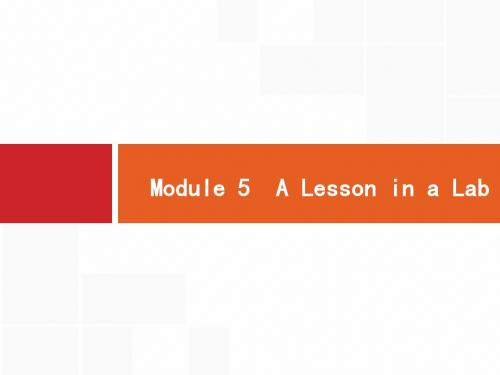
expansive
adj.易膨胀的,
必修1
重点单词 重点短语
Module 5
A Lesson in a Lab 5 -5-
典句背诵
语法填空
14.contract v.收缩;感染;订约→contraction n.收缩,缩写式 15.substance n.物质 →substantial adj.大量的,坚固的,实质的 16.mixture n.混合物→mix vt.& vi.(使)混合 17.electricity n.电→electrical adj.与电有关的→electric adj.发电的;用电的 18.conclusion n.结论→conclude vt.得出结论 19.reaction n.反应→react vi.反应 20.equipment n.设备;装备→equip vt.装备 21.partial adj.部分的;局部的→part n.部分 22.boil vt.煮;煮沸→boiling adj.沸腾的→boiled adj.煮沸的;烧滚的 23.balance n.天平→balanced adj.平衡的 24.astonished adj.吃惊的;惊愕的→astonishing adj.令人吃惊的→astonish vt. 使吃惊 →astonishment n.吃惊
必修1
重点单词 重点短语
Module 5
A Lesson in a Lab 4 -4-
典句背诵
语法填空
1.liquid n.液体 2.oxygen n.氧气 3.aim n. 目标,目的 vt.瞄准,针对,旨在,打算 4.form vi.形成 5.dissolve vi.溶解;分解;分离 6.flame n.火焰 7.facility n.设备;工具 8.stage n.阶段;时期 9.rust vi.生锈 10.ordinary adj.普通的;平常的 11.float vt.漂浮 12.lecture n.演讲;讲座 13.expand vi.膨胀;扩大→expansion n.膨胀 → 广阔的
必修一module 5A Lesson in a lab知识点讲解及练习

MODULE 5 A Lesson in a labI 重点单词________ 液体________ 膨胀________ 收缩________ 物质________ 混合物________ 煮;煮沸________ 普通的,平常的________ 结论________ 形成________ 溶解;分解;分离________ 天平________ (化学)反应________ 钾________ 钠________ 钙________ 镁________ 铝________ 锌________ 部分的;局部的________ 铜________ 氧化物________ 氧气________ 电________ 蒸汽,水汽________ 漂浮________ 反应________ 有关电的;用电的________ 设备,装备________ 夹子;小镊子________ 火焰________ 设备,工具________ 演讲________ (大学的)科,系________ 吃惊的,惊愕的II 重点词组________ 过去常常做某事________ 在最后二十年________ 以…自豪________ 应该做某事________ 被期望做某事________ 和…不同________ 遗漏,省略,忽略________ 和…一样________ 想起,认为________ 让…按次序排列________ 确保________ 至少________ 向…学习________ 把…加在…上________ 阻止Section I Introduction , vocabulary and speaking语言知识点精讲Steel is a mixture of iron and other substances. 钢是铁和其他物质的混合物l)句中的substance 意为’_______ ”,是________ 名词________________________ ?它是由什么物质组成的?_________________________盐是我们烹任时用的东西。
必修1-Module5-A-Lesson-in-a-Lab重难知识点总结

Unit 5. A Lesson in a Lab一.重点词汇及拓展1.contract vi.& n.收缩;(订)合约2.float vi.漂浮3.expand vi.膨胀→expansion n.膨胀4.mixture n.混合物→mix v.混合5.electricity n.电→electrical adj.电的,和电有关的→electric adj.发电的,用电的6.reaction n.反应→react vi.反应7.equipment n.设备,装备→equip vt.装置8.astonished adj.吃惊的;惊愕的→astonishing adj.令人吃惊的→astonish vt.惊讶,吃惊→astonishment n.惊讶,惊奇9.aim n.& v.目标;以……为目标→aimless adj.漫无目的的10.balance n.天平;平衡→balanced adj.平衡的二.重点短语1.react with与……反应2.add ...to往……加入3.used to过去常常4.be proud of因……而自豪5.be supposed to理应;应该6.put...in order 使……整齐;使……有条理7.keep ... out of 防止……进入;不让……靠近……三.重点句型1.It is hard to think of a world without metals.很难想象一个没有金属的世界。
2.Here is a table with the metals that react most at the top,and the metals that react least at the bottom.这儿有一个图表,那些反应最强烈的金属在上部,反应最不强烈的在下部。
3.The closer you are,the more you'll see.你靠得越近,你看到的就越多。
Module 5 A+Lesson+in+a+Lab
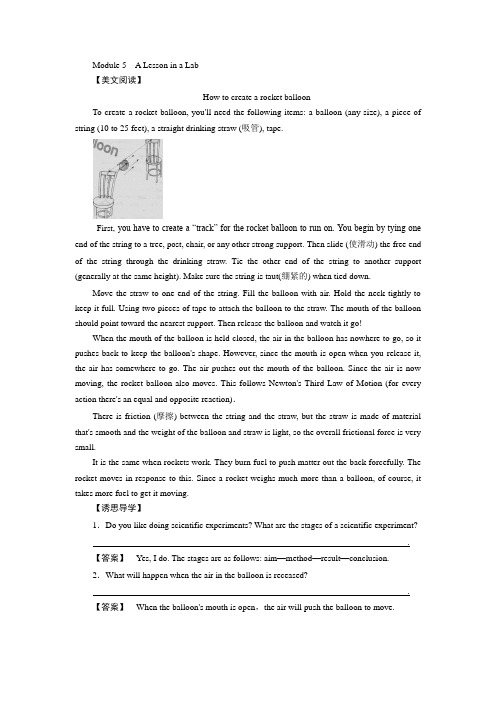
Module 5 A Lesson in a Lab【美文阅读】How to create a rocket balloonTo create a rocket balloon, you'll need the following items: a balloon (any size), a piece of string (10 to 25 feet), a straight drinking straw (吸管), tape.First, you have to create a “track” for the rocket balloon to run on. You begin by tying one end of the string to a tree, post, chair, or any other strong support. Then slide (使滑动) the free end of the string through the drinking straw. Tie the other end of the string to another support (generally at the same height). Make sure the string is taut(绷紧的) when tied down.Move the straw to one end of the string. Fill the balloon with air. Hold the neck tightly to keep it full. Using two pieces of tape to attach the balloon to the straw. The mouth of the balloon should point toward the nearest support. Then release the balloon and watch it go!When the mouth of the balloon is held closed, the air in the balloon has nowhere to go, so it pushes back to keep the balloon's shape. However, since the mouth is open when you release it, the air has somewhere to go. The air pushes out the mouth of the balloon. Since the air is now moving, the rocket balloon also moves. This follows Newton's Third Law of Motion (for every action there's an equal and opposite reaction).There is friction (摩擦) between the string and the straw, but the straw is made of material that's smooth and the weight of the balloon and straw is light, so the overall frictional force is very small.It is the same when rockets work. They burn fuel to push matter out the back forcefully. The rocket moves in response to this. Since a rocket weighs much more than a balloon, of course, it takes more fuel to get it moving.【诱思导学】1.Do you like doing scientific experiments? What are the stages of a scientific experiment?.【答案】Yes, I do. The stages are as follows: aim—method—result—conclusion.2.What will happen when the air in the balloon is receased?.【答案】When the balloon's mouth is open,the air will push the balloon to move.Period ⅠPreviewing(教师用书独具)●教学目标本课时主要是通过学生对学案所给出的内容的学习,了解本课文中所出现的词汇,初步了解课文以及相关的背景知识,对下一堂课对课文的全面理解起到一个铺垫作用。
外研版 必修一 Module5 A Lesson in a Lab_课件(38张PPT).ppt

①keep/lose one's balance保持/失去平衡 break the balance破坏平衡 make up the balance补足差额 on balance总的来说 keep the balance of nature保持生态平衡 ②balance A against B 权衡/比较A与B ③balanced adj.保存平衡的 a balanced diet均衡饮食
He is taller by far than his brother. =He is by far the taller of the two brothers. 他比他兄弟高多了。(注意by far的不同位置) Are you feeling any better today? 你今天感觉好些了吗?
【答案】 A
翻译句子
①——我可以借你的字典吗? ——可以,拿去吧。
—
.
—
.
②我要先走一步,告诉他们你在路上。
. 【答案】 ①Can I borrow your dictionary?Yes, go ahead. ②I'll go ahead and tell them you're on the way.
Integrating Skills & Grammar
教师用书独具演示
●教学目标 (1)熟记学案中所列出的单词和短语。 (2) 通 过 学 案 中 所 给 出 的 重 点 单 词 和 重 点 短 语 的 学 习,让学生能够正确理解和使用这些单词和短语,能够运 用这些词语造句。
(3)听懂课文中所给出的听力材料。 (4)通过对语法的教学让学生能够理解并能够正确运 用形容词和副词的比较级。
【对接高考】
高中英语 Module 5 A Lesson in a Lab(典句精讲)教案 外研版必修1

典句精讲1.The science facilities ar e very good with laboratories that have all the latest equipment.这些科研设备非常好,实验室配有最新的设备。
【巧解句构】w ith在此句中意思为“带有……”,其引导的短语对句子作附加说明,that haveall the latest equipment为定语从句,修饰laboratories。
2....and these are always very interesting,as the lectures are peopl e who have made real discoveries in their areas of science.这些讲座总是很有趣的,因为作讲座的人是在各自的科研领域里真正有所发现的人。
【巧解句构】as conj.“因为,由于”,在本句中引导原因状语从句。
as作连词可以引导多种状语从句,主要有时间、原因、方式、比较、让步等从句。
3.Th e Nobel Prize is the highest scient ific prize there is,so we should be very proud of that.诺贝尔奖是目前科学方面的最高奖,因此我们为此感到骄傲。
【巧解句构】there is为定语从句,修饰prize。
4.It is important to know how they r eact with different substances,fo r example,water and oxygen.了解它们如何同像水、氧气这样的物质发生反应的是非常重要的。
【巧解句构】1)it是形式主语,真正的主语是动词不定式to后面的部分。
2)how引导的句子作know的宾语。
【要点剖析】react with同……发生反应。
for example是不完全列举,“例如”。
Module 5 A Lesson in a Lab
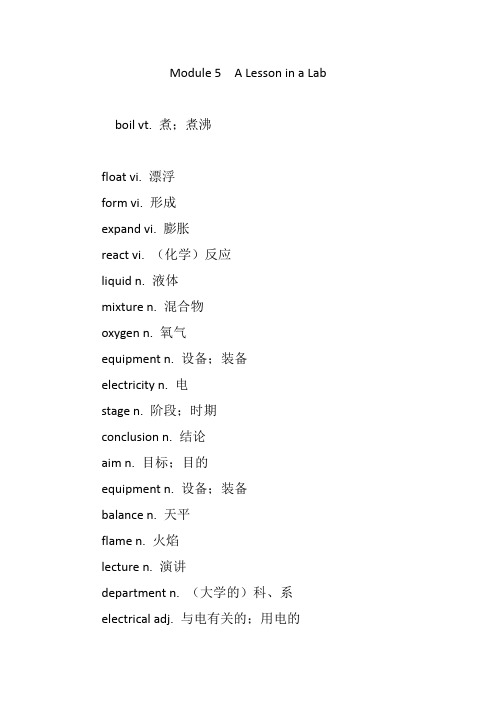
Module 5 A Lesson in a Lab boil vt. 煮;煮沸float vi. 漂浮form vi. 形成expand vi. 膨胀react vi. (化学)反应liquid n. 液体mixture n. 混合物oxygen n. 氧气equipment n. 设备;装备electricity n. 电stage n. 阶段;时期conclusion n. 结论aim n. 目标;目的equipment n. 设备;装备balance n. 天平flame n. 火焰lecture n. 演讲department n. (大学的)科、系electrical adj. 与电有关的;用电的ordinary adj. 普通的;平常的astonished adj. 吃惊的;惊愕的add...to... 往……加入……used to 过去(常常)……in the area of 在……领域be proud of 为……感到骄傲/自豪be supposed to 应当;理应push down 向下按;推到keep down 控制;限制react with 与……产生化学反应keep...out of 防止……进入put...in order 把……按顺序排列draw a/the conclusion 得出结论test tube 试管a quarter 四分之一three quarters 四分之三a third 三分之一a half 一半contract vi. 收缩rust vi. 生锈dissolve vi. 溶解;分解;分离substance n. 物质reaction n. 反应steam n. 蒸汽;水汽facility n. (常作复数)设备;工具tongs n. (复)夹子;小钳子partial adj. 部分的;局部的exist vi. 存在;生存solid n. 固体surface n. 表面tube n. 管;管子(1)学习倍数的表示法。
高中英语Module 5 A Lesson in a Lab 优秀课件1

⑨reaction/r
k n/n.反响
⑩put sthin order 把某物按顺序排列
[3]that react most是that引导的定语从句,修饰the metals。
⑪at the top (of)在(……)顶端
⑫form/f m/vi.&vt.形成
⑬oxide/ ksa d/n.氧化物
A group of R.O.Korean researchers have found a way to turn cigarette butts into the materials required for batteries.Kim Gil-Pyo from the Seoul National University says he saw people throwing away cigarette butts and that got him thinking.He began wondering if something useful could be made from them.
steam
Iron Copper
Reacts slowly Partial⑭ reaction
Partial reaction No reaction
*an oxide=another substance+oxygen
A Simple Scientific Experiment Below is a description of a simple scientific experiment.[4]It shows us how iron reacts with air and with water.[5] Aim⑯: To find out if iron rusts⑰[6](a) in dry air;(b) in water that has no air in it[7] (air-free⑱water);(c) in ordinary⑲ water. Apparatus:3 clean iron nails;test tubes;test tube holder;cotton wool;oil;Bunsen burner.
高一英语 Module 5 A Lesson in a Lab课件 外研必修1

MODULE 5 A Lesson in a Lab
Reading and Vocabulary
Passage B A Simple Scientific Experiment
B
B.aim
D.method
A.result
C.conclusion
D
A
C
The stages of a scientific experiment
air
doesn’t rust
boil
make sure
Adding
keep
nails
air-free
half-fill
ordinary
Iron in air-free water
Method (1) Half- fill a test tube with water. (2) Boil the water for three minutes. (3) Put two or three nails in the water. (4) Add some oil to the water. This will keep air out of the water. (5) Leave the tube for one week.
Iron in ordinary water
Iron nails rust in wet air.
Passage B
cotton wool
nails
water
water
water
The nails haven’t rusted
The nails do not rust
The nails rust
some oil
高中英语Module 5 A Lesson in a Lab 教案

Module 5 A Lesson in a LabThe First Period ReadingTeaching goals教学目标1. a. 重点词汇expand, contract, conclusion, method, liquid, solid, iron, mixture, oxygen, electricity, aim, equipment, react, result, steam, substance, boil, float, form, dissolve, rustb. 重点句式It is hard to think of a world without metals.It is important to know how they react with different substances, for example, water and oxygen.This makes sure there is no air in the water.2. Enable the students to describe a scientific experiment.Enable the students to learn some words concerning scientific experiment.3. Help the students learn about the steps of a simple scientific experiment so that they can describe a similar one.Teaching important points教学重点Help the students learn how to describe a simple scientific experiment.Teaching difficult points教学难点Help the students understand the two tables of Passage A and Passage B.Teaching procedures & ways教学过程与方式Step ⅠWarming-upThe purpose of this part is to let the students know and get familiar with the new words in INTRODUCTION: expand, contract, mixture, substance, oxygen and electricity. First, write down the words on the black-board, and then teach them the meaning of each word by questioning.T: Hello, everyone! Do you know the program Lucky 52 on CCTV?Ss: Yeah!T: OK, now suppose I’m Li Yong, and you are competitors. Here are six words on the blackboard. What you should do is to guess the meanings of them. If you can’texpress them in English, you may say in Chinese. The quicker, the better. Are you clear?Ss: Yes.T: Listen. What do we take in when we breathe?S1: Air.T: Right. But not exact.S2: 氧气。
- 1、下载文档前请自行甄别文档内容的完整性,平台不提供额外的编辑、内容补充、找答案等附加服务。
- 2、"仅部分预览"的文档,不可在线预览部分如存在完整性等问题,可反馈申请退款(可完整预览的文档不适用该条件!)。
- 3、如文档侵犯您的权益,请联系客服反馈,我们会尽快为您处理(人工客服工作时间:9:00-18:30)。
Teaching aims:1. To introduce some general science .2. To learn some words related to the theme of this module .3. To develop speaking ability by practicing saying the numbers, especially the fractions.Important and difficult points:1. Arouse the students’ interests and love in science.2. Enable the students to understand some elements about the chemistry lab.3. Make the students know how to read the numbers.Teaching procedures:IntroductionActivity 1The aim of the activity is to ask the students to finish the quiz about general science to arouse their interest in science. The activity can be done as follows: Firstly, ask the students to go through the following the quiz and make their choice on their own.Quiz: How much do you know about general science?1. Water exists __________(a) as a solid, a liquid and a gas (b) as a solid and a liquid only2. When you heat a metal, it will ___________(a) expand (b) contract3. Steel is mixture of_____________.(a) iron and other substances. (b) iron and oxygen4. _______________ of the earth’s surface is water.(a) Two-thirds (b) 50%5. The distance of the sun from the earth is ______________ kilometers.(a) 25,500 (b) 150,500,5006.The earth is 4.6______________ years old.(a) million (b) billion7. The earth is ______________ the moon(a) twice as large as (b) forty-nine times larger thanThen put the students in pairs to compare their answers and call back the answers from the class.Finally ask them to listen to the tape about the above quiz and check their answers.Answers: 1. a; 2. a; 3. a 4. a; 5. b; 6. b; 7. b. Activities 2 & 3The teacher can prepare some cards about different things for the class at first. Before showing the students the cards, the teacher can say to the whole class: Things can be divided into three kinds, natural, man-made, and either natural or man-made, now I’ll show you some cards in my hand, can you tell me which are natural, man-made or both?After this, the teacher can continue to say to the whole the class: Can you give some examples? Then divide the whole class into two big groups to compete. The teacher can ask the Ss to speak out as many examples as possible and write down theFinally, ask the Ss to open their books at Page 41 and read the words in the box aloud. If possible, they can look up the words to know what they mean. Of course, the above competition will continue, that is to say, at this moment, the teacher can ask the Ss to put the words in the box on Page 41 in their books in the above table. Vocabulary and SpeakingActivity 1The aim of the activity is to have the students know how to read the long numbers. So the activity can be done like this:Before dealing with the activity, the teacher had better build up a long number by having the students say an increasing sequence, eg:3three33thirty-three333 three hundred and thirty-three3, 333 three thousand, three hundred and thirty-three33, 333 thirty-three thousand, three hundred and thirty-threeAt this time, most of the Ss will know the way of reading these long numbers: where to say “million”, “thousand”, and “hundred” . So in order to consolidate what they just learned, the teacher can practice saying the numbers at the top of Page 42 with the students to make sure the Ss have the correct intonation.Then ask the Ss to go through the rest of the numbers in Activity 1 and find the errors individually according to the directions.Finally the teacher calls back the answers from the class.Answers: 1)The word “thousand” is missing after “four hundred and seventy”;2)The word “one”(or “a”) is missing before “hundred million”.Activity 2Firstly, the teacher point at the fractions and say them in English. At the same time the teacher have the Ss repeat them after him or her.Then the teacher and the Ss make an analysis about the rules of reading fractions in English together.Finally the teacher ask the Ss to read the rest of the fractions in Activity 2 on Page 42 in their books in English on their own. If necessary, the teacher can write down the correct answers on the blackboard to check what they read.Answers: 1. two-fifths; 2. five-eighths; 3. nine-tenths 4.three-eighths;5.five-sixths.Activity 3The teacher should introduce the concept of percentage at first, and then the teacher write down some percentages on the blackboard and read them out in English.Eg: 35%→ thirty-five percent (or: 35 percent); 50 percent equals a half.Then have the Ss practice reading aloud the following percentages: 40%; 55%; 85%.Finally have the Ss work in pairs to describe the fractions in Activity 2 as percentages in English .Answers: 1. A quarter is the same as 25%; 2.One third is the same as 33.33r%(thirty-three point three three recurring percent); 3.Four-fifths is the same as 80%; 4. One tenth is the same as 10%; 5. Three-quarters is the same as 75%; 6. One half is the same as 50%; 7. Two-thirds is the same as 66.66r%(sixty-six point six six recurring percent); 8. Two-fifths is the same as 40%; 9. Five-eighths is the same as 62.5%(sixty-two point five percent); 10. Nine-tenths is the same as 90%; 11. Three-eighths is the same as 37.5%(thirty-seven point five percent); 12.Five-sixths is the same as 83.33r%(eighty-three point three three recurring percent).Homework:1. Preview the reading part.2.Work in pairs to finish Activities 4& 5 on Page 43 .Teaching aims and demands:⒈To learn about some vocabulary and knowledge related to science and experiments⒉To know about some metals and get to know their main uses in our lives⒊To make the students know how to do a simple experiment and write the reportabout it in English⒋To deal with all the activities1-6 about passage A and passage B on page 44-45⒌To develop students’ expression ability as well as reading ability by practicingthese two passages⒍To raise students’ interests in science and form the rigorous scientific attitude. Teaching key points:⒈To make the students understand and grasp the vocabulary and knowledge related to science and experiments⒉To enable the students to know how to read some passages about simple scientific experimentsTeaching difficulties:To make students learn how to write an experiment report in EnglishTeaching methods:⒈Communicative Approach⒉Task-based Approach⒊Aural-oral Approach with the help of the multi-media computer and the recorder Teaching aids:Multi-media computer; Software; PowerPoint; RecorderTeaching procedures:Step 1:Lead-inAt first show the students the picture of a lab with the help of computerThen design the following questions and ask the students to discuss them in groups:1.Are you interested in doing scientific experiments?2.Suppose you want to do a chemical experiment about some metals, do you think it is necessary to know about how they react with other substances?3.In order to carry out an experiment successfully, what should you prepare for it?This step is to warm up the students and raise their interests to speak English in class. Because all these questions are very close to the students’ daily life and studyingStep 2:Pre-readingTeacher: Since you are interested in doing scientific experiments, now let’s get to know some vocabulary and knowledge related to science and experiments.At the same time I can type out some pictures about some metals on the screen with the help of the computer as follows:⑴potassium(钾) ⑵sodium(钠) ⑶calcium(钙) ⑷magnesium(镁)⑸aluminium(铝) ⑹zinc(锌) ⑺iron(铁) ⑻copper(铜)As I type out each of the above pictures, I can ask the students like this: What’s this? And what can it be used for?At this moment the students’ interests are probably approaching a climax. So I further ask them like this: Do you want to know more about these metals? And do you know how we can use these metals bette r? Well, this is what we’ll study very soon.This step is employed to create a language environment for students’ communication and arouse their interests in reading passage A and passage B on page 44-45Step 3: Re adingPassage AT: Well, let’s read through passage A with the tape of it very quickly to try to catch its main idea. Then finish Activity 2 on page 44 and give your reasons.Next, ask the Ss to read passage A very carefully to find out the answers in Activity 3 on page 44. Finish this activity by multi-media computer. It can be designed as follows:1.Which of the metals in the table reacts the most with oxygen and water?Potassium, calcium and sodium.2.What happens when you heat calcium in oxygen?It burns to form an oxide.3.Which metals react with steam?Magnesium, aluminium and zinc.4.Does iron have a slow or fast reaction with steam?It has a slow reaction.5.Does copper react with water?No, it doesn’t.Passage BT: Well, from passage A we can see how interesting the experiment about the reaction of metals is! But do you know how we can carry out a chemical experimentin a lab successfully? And what is the correct order to describe a scientific experiment?Ask the Ss to look at Activity 1 on page 44 and give them about 2 minutes to discuss it. Then collect the answers from them. At the same time type out the correct answer on the screen with the computer as follows:aimresultconclusionT: Now, let’s come to see “ A simple scientific experiment”!Then play the tape of passage B for the students and ask them to read the passage with the tape quickly and finish Activity 4 on page 44.In order to lead the students to read the text very carefully, the followingtask-based questions can be signed to ask them to answer:⑴Can you guess the meaning of the word “apparatus” through the context? Have you known all of the apparatuses of this experiment?⑵In the second part of the experiment, why must you boil the water? And then why do you add some oil to the water?For Question 1, some students maybe feel strange to some apparatuses. If so , the following pictures can be typed out with the help of computer to help Ss to know about:Test tube holderBunsen burnerThen in order to make the Ss consolidate what they read in passage B and check if they have understood the experiment very well, Activity 5 on page 46 can be typed out on the screen with the help of computer as a task-based activity。
